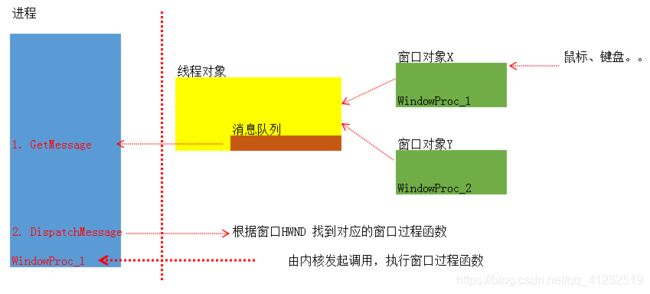第一个窗口
文章目录
-
- 一、设计一个窗口
- 二、注册窗口
- 三、创建一个窗口
- 四、显示窗口
- 五、消息循环
- 六、系统调用我们写的函数处理消息
- 七、系统处理不相关的消息
- 八、在进程中退出
- 九、win32中打印消息
- 十、完整代码
一、设计一个窗口
TCHAR className[] = "My First Window"; // 创建窗口类的对象
WNDCLASS wndclass = {0}; //一定要先将所有值赋值
wndclass.hbrBackground = (HBRUSH)COLOR_MENU;//窗口的背景色
wndclass.lpfnWndProc = WindowProc; //窗口过程函数(创建一个处理消息的函数)
wndclass.lpszClassName = className; //窗口类的名字
wndclass.hInstance = hInstance; //定义窗口类的应用程序的实例句柄
二、注册窗口
RegisterClass(&wndclass);
三、创建一个窗口
// 创建窗口
HWND hwnd = CreateWindow(
className, //类名
TEXT("我的第一个窗口"), //窗口标题
WS_OVERLAPPEDWINDOW, //窗口外观样式
10, //相对于父窗口的X坐标
10, //相对于父窗口的Y坐标
600, //窗口的宽度
300, //窗口的高度
NULL, //父窗口句柄,为NULL
NULL, //菜单句柄,为NULL
hInstance, //当前应用程序的句柄
NULL); //附加数据一般为NULL
if(hwnd == NULL) //是否创建成功
return 0;
四、显示窗口
ShowWindow(hwnd, SW_SHOW);
五、消息循环
MSG msg;
while(GetMessage(&msg, NULL, 0, 0))
{
TranslateMessage(&msg); //翻译一下,比如 你按了键盘上的那个键,光标在哪,更加具体,后面处理这个消息就方便了
DispatchMessage(&msg); //将翻译完的消息,发送回系统
}
六、系统调用我们写的函数处理消息
LRESULT CALLBACK WindowProc(
IN HWND hwnd, //句柄
IN UINT uMsg, //消息类型
IN WPARAM wParam,
IN LPARAM lParam
)
七、系统处理不相关的消息
如果不是我们关注的消息,就交给系统去处理
{
return DefWindowProc(hwnd,uMsg,wParam,lParam);
}
八、在进程中退出
{
switch(uMsg)
{
case WM_DESTROY:
{
PostQuitMessage(0);
return 0;
}
}
九、win32中打印消息
#include "stdio.h"
void __cdecl OutputDebugStringF(const char *format, ...)
{
va_list vlArgs;
char *strBuffer = (char*)GlobalAlloc(GPTR, 4096);
va_start(vlArgs, format);
_vsnprintf(strBuffer, 4096 - 1, format, vlArgs);
va_end(vlArgs);
strcat(strBuffer, "\n");
OutputDebugStringA(strBuffer);
GlobalFree(strBuffer);
return;
}
OutputDebugStringF("%x",uMsg);
十、完整代码
// test.cpp : Defines the entry point for the application.
//
#include "stdafx.h"
#include "stdio.h"
//*********************************申明消息类型函数*****************************
void __cdecl OutputDebugStringF(const char *format, ...)
{
va_list vlArgs;
char *strBuffer = (char*)GlobalAlloc(GPTR, 4096);
va_start(vlArgs, format);
_vsnprintf(strBuffer, 4096 - 1, format, vlArgs);
va_end(vlArgs);
strcat(strBuffer, "\n");
OutputDebugStringA(strBuffer);
GlobalFree(strBuffer);
return;
}
//********************************************************************************************
//*********************************申明处理函数**********************************************
LRESULT CALLBACK WindowProc( //处理函数申明
IN HWND hwnd,
IN UINT uMsg,
IN WPARAM wParam,
IN LPARAM lParam
);
//********************************************************************************************
//*********************************主程序**********************************************
int APIENTRY WinMain(HINSTANCE hInstance,
HINSTANCE hPrevInstance,
LPSTR lpCmdLine,
int nCmdShow)
{
// TODO: Place code here.
//窗口的类名
TCHAR className[] = "My First Window";
// 创建窗口类的对象
WNDCLASS wndclass = {0}; //一定要先将所有值赋值
wndclass.hbrBackground = (HBRUSH)COLOR_MENU; //窗口的背景色
wndclass.lpfnWndProc = WindowProc; //窗口过程函数
wndclass.lpszClassName = className; //窗口类的名字
wndclass.hInstance = hInstance; //定义窗口类的应用程序的实例句柄
//注册窗口类
RegisterClass(&wndclass);
// 创建窗口
HWND hwnd = CreateWindow(
className, //类名
TEXT("我的第一个窗口"), //窗口标题
WS_OVERLAPPEDWINDOW, //窗口外观样式
10, //相对于父窗口的X坐标
10, //相对于父窗口的Y坐标
600, //窗口的宽度
300, //窗口的高度
NULL, //父窗口句柄,为NULL
NULL, //菜单句柄,为NULL
hInstance, //当前应用程序的句柄
NULL); //附加数据一般为NULL
if(hwnd == NULL) //是否创建成功
return 0;
// 显示窗口
ShowWindow(hwnd, SW_SHOW);
//消息循环
MSG msg;
while(GetMessage(&msg, NULL, 0, 0))
{
TranslateMessage(&msg);
DispatchMessage(&msg);
}
return 0;
}
//*********************************************************************************
//**********************处理函数************************************************
LRESULT CALLBACK WindowProc(
IN HWND hwnd,
IN UINT uMsg,
IN WPARAM wParam,
IN LPARAM lParam
)
{
switch(uMsg)
{
case WM_CREATE:
{
OutputDebugStringF("WM_CREATE:%x",uMsg); //创建窗口
return 0;
}
case WM_DESTROY:
{
PostQuitMessage(0); //退出当前窗口
return 0;
}
}
return DefWindowProc(hwnd,uMsg,wParam,lParam);
}
//*********************************************************************************
